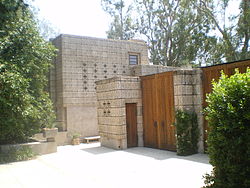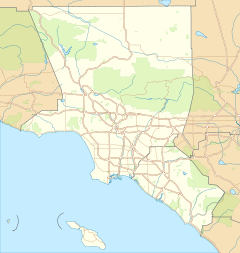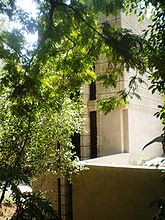- Millard House
-
Millard HouseMillard House, July 2008
Location: 645 Prospect Crescent, Pasadena, California Coordinates: 34°9′19″N 118°9′39″W / 34.15528°N 118.16083°WCoordinates: 34°9′19″N 118°9′39″W / 34.15528°N 118.16083°W Built: 1923 Architect: Frank Lloyd Wright; Lloyd Wright Architectural style: Other Governing body: Private NRHP Reference#: 76000493
[1]Added to NRHP: December 12, 1976 Millard House, also known as La Miniatura, is a textile block house designed by Frank Lloyd Wright and built in 1923 in Pasadena, California. It was listed on the National Register of Historic Places in 1976.
Contents
Wright's textile block houses
The Millard House was the first of Frank Lloyd Wright's four "textile block" houses — all built in Los Angeles County in 1923 and 1924. Wright took on the Millard House following his completion of the Hollyhock House in Hollywood and the Imperial Hotel in Japan.
By this time, Wright felt typecast as the Prairie house architect and sought to broaden his architectural vision.[2] Wright turned to the concrete block as his new building material. Wright wrote in his autobiography that he chose to build with concrete blocks as they were "the cheapest (and ugliest) thing in the building world," and he wanted to see "what could be done with that gutter-rat."[3] The textile-block houses were named for their richly textured brocade-like concrete walls.[4] The style was an experiment by Wright in modular housing;[5] he sought to develop an inexpensive and simple method of construction that would enable ordinary people to build their own homes with stacked blocks.[5] By adding ornamental designs to mass-produced blocks, Wright hoped the blocks could become a "masonry fabric capable of great variety in architectural beauty."[2] One writer has described Wright's concept this way: "By unifying decoration and function, exterior and interior, earth and sky — perforated blocks served as skylights — Wright saw his Textile Block Method approach as an utterly modern, and democratic, expression of his organic architecture ideal."[5]
Design of Millard House
Wright was commissioned to build Millard House by Alice Millard, a rare-book dealer for whom Wright had built a home in Highland Park, Illinois in 1906. Seeking to integrate the Millard House with the land, Wright designed the home to cling to the lot's steep ravine, nestled it among the trees, and fabricated the home's concrete blocks using sand, gravel and minerals found on the property.[3] By using roughly textured, earth-toned blocks, he sought to blend the house with the color and form of the trees and hillside. While the design was in most ways a departure from Wright's prior work, it was consistent with his lifelong love of natural materials and his belief that buildings should complement their surroundings. He later said that Millard House "belonged to the ground on which it stood."[2]
The blocks were created in wooden molds with patterns on the outside and smooth on the inside. The blocks feature a symmetrical pattern of a cross with a square in each corner.[3] Wright reinforced the blocks using conventional mortar.[3] The project cost $17,000 — 70% more than the $10,000 budget Millard had given to Wright.[3] Some accounts state that the builder walked off the job, "leaving Wright to finish the project himself, out of his own pocket."[6]
The 2,400-square-foot (220 m2) house consists of a vertical three-story block. The first floor has the kitchen, servant's room and a dining room opening onto a terrace with a reflecting pool. The second floor has the main entrance, guest room, and a two-story living room with a fireplace and balcony. The third floor contained Millard's bedroom with a balcony overlooking the living room and outdoor terrace.[2]
Like many of Wright's homes, Millard House suffered from leaks during rains. After the house flooded in a storm, Millard wrote a letter to Wright complaining about the inadequate storm drain that resulted in the basement filling entirely with muddy water and the water rising to six inches (152 mm) in the dining room.[3]
Millard added a separate studio in 1926, designed by Wright's son, Lloyd Wright.[3]
Critical response
The initial critical response to Millard House and the textile block structures was not positive. The homes were greeted with "howls of laughter", as Beaux Arts-trained architects were "appalled" to see a common building material used for the facades and interior walls of expensive homes.[2] As The New York Times later said of the California houses built by Wright in the 1920s: "It didn’t help that he was obsessed at the time with an untested and (supposedly) low-cost method of concrete-block construction. What kind of rich person, many wondered, would want to live in such a house? Aside from the free-spirited oil heiress Aline Barnsdall, with whom he fought constantly, his motley clients included a jewelry salesman, a rare-book dealing widow and a failed doctor."[7]
However, Wright himself took great pride in Millard House. He said of it: "I would rather have built this little house than St. Peter's in Rome."[3][8][9] Over the years, critical views of Millard House became positive, and it is now considered one of Wright's finest works.
In 1965, the Los Angeles Times columnist Art Seidenbaum wrote: "Environmentally, the place is fascinating because it still looks modern in a neighborhood that is gracious but aging. Or, maybe better, the Millard house is of no time and its own place."[6]
In 1969, Millard House was ranked as one of the 12 most significant landmarks in the Los Angeles area by a panel of ten distinguished citizens and architecture experts.[10]
In 1980, The New York Times noted that the Millard House was known around the world and ranked it among the few buildings in Los Angeles that "have become classic works of the 20th Century."[11]
See also
- List of Registered Historic Places in Los Angeles County, California
- Ennis House, Samuel Freeman House and Storer House — Wright's other three textile block houses
References
- ^ "National Register Information System". National Register of Historic Places. National Park Service. 2008-04-15. http://nrhp.focus.nps.gov/natreg/docs/All_Data.html.
- ^ a b c d e Charles Lockwood (1983-01-30). "L.A. Homes Mark Architect's Most Turbulent Period". Los Angeles Times.
- ^ a b c d e f g h Martha Groves (2008-01-27). "Public gets rare look at a Wright gem: Architecture buffs visit one of his 'textile block' houses, La Miniatura in Pasadena, last on view in 1992". Los Angeles Times. http://www.latimes.com/news/local/la-me-wright27jan27,1,1649919.story.
- ^ "Above the Strip in Hollywood: Frank Lloyd Wright's Storer House on the market for $1 million". Los Angeles Times. 1981-06-06.
- ^ a b c Hugh Hart (2004-09-26). "Architecture; When the answers aren't just concrete". Los Angeles Times.
- ^ a b Art Seidenbaum (1965-10-17). "The Southland Houses That Frank Lloyd Wright Built". Los Angeles Times.
- ^ Hugh Eakin (2005-08-14). "Fixer-Uppers That Need Love and Concrete". The New York Times. http://www.nytimes.com/2005/08/14/arts/design/14eaki.html?_r=1&oref=slogin.
- ^ Janette Williams (2008-07-20). "Wright’s ‘La Miniatura’ is restored". Pasadena Star-News.
- ^ "Tour La Miniatura". Wright in Chicagoland. 2008-01-26. http://chicagowright.blogspot.com/.
- ^ Art Seidenbaum (1969). "Los Angeles Landmarks: The Top Dozen". Los Angeles Times.
- ^ Paul Goldberger (1980-11-06). "Design Notebook: A Hollywood House Worthy of an Oscar". Los Angeles Times.
External links
U.S. National Register of Historic Places Topics Lists by states Alabama • Alaska • Arizona • Arkansas • California • Colorado • Connecticut • Delaware • Florida • Georgia • Hawaii • Idaho • Illinois • Indiana • Iowa • Kansas • Kentucky • Louisiana • Maine • Maryland • Massachusetts • Michigan • Minnesota • Mississippi • Missouri • Montana • Nebraska • Nevada • New Hampshire • New Jersey • New Mexico • New York • North Carolina • North Dakota • Ohio • Oklahoma • Oregon • Pennsylvania • Rhode Island • South Carolina • South Dakota • Tennessee • Texas • Utah • Vermont • Virginia • Washington • West Virginia • Wisconsin • WyomingLists by territories Lists by associated states Other  Category:National Register of Historic Places •
Category:National Register of Historic Places •  Portal:National Register of Historic PlacesCategories:
Portal:National Register of Historic PlacesCategories:- Frank Lloyd Wright buildings
- Houses on the National Register of Historic Places in California
- National Register of Historic Places in Pasadena, California
- History of Los Angeles County, California
- Modernist architecture in California
- 1923 architecture
- Houses in California
- Buildings and structures in Pasadena, California
- Houses in Los Angeles County, California
Wikimedia Foundation. 2010.





